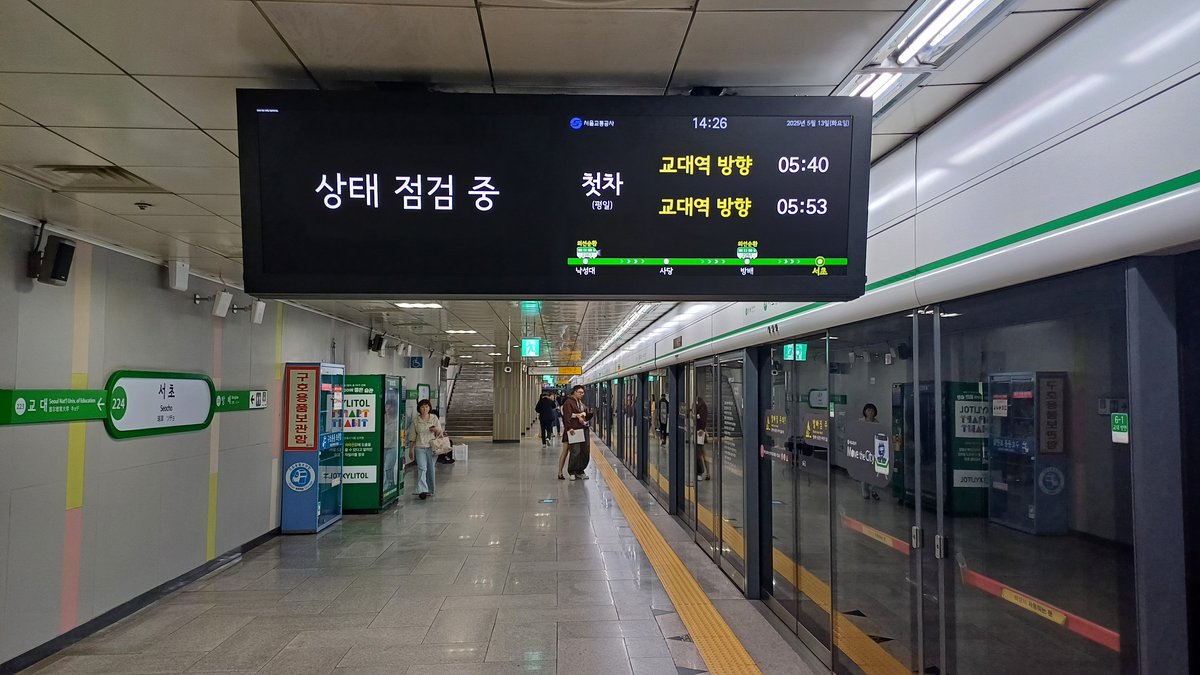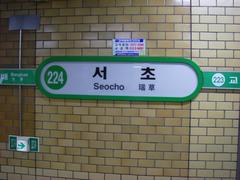
Seocho Station Visiting Hours, Tickets, and Guide to Seoul Historical Sites
Date: 14/06/2025
Introduction
Seocho Station, nestled in the heart of Seoul’s affluent Seocho District, stands as a pivotal gateway connecting visitors to the city’s vibrant culture, business hubs, and historical landmarks. Since its inauguration in December 1983 as part of the expansive Seoul Subway Line 2, Seocho Station has facilitated seamless urban mobility and symbolizes the rapid transformation of the area from rural farmland into a dynamic metropolitan center. Its strategic location offers immediate access to renowned attractions such as the Seoul Arts Center, Gangnam-daero boulevard, Bongeunsa Temple, Seorae Village, and the bustling Express Bus Terminal, blending modernity with rich cultural heritage.
Visitors to Seocho Station can expect a well-equipped, accessible environment featuring multilingual signage, elevators, convenience stores, and comprehensive safety measures. The station operates daily from early morning until midnight, with flexible ticketing options including the rechargeable T-money card and the newly introduced Climate Card Tourist Pass. This comprehensive guide provides essential knowledge about Seocho Station’s history, facilities, transportation connections, and notable nearby sites, ensuring a safe and memorable journey through southern Seoul.
For further information, consult resources such as the official Seoul Metro website, Seoul Solution, and Wikipedia: Seocho District.
Table of Contents
- Historical Evolution and Urban Significance
- Visiting Seocho Station: Hours, Tickets & Facilities
- How to Get to Seocho Station
- Things to Do Near Seocho Station
- Visitor Tips and Safety
- Frequently Asked Questions (FAQ)
- Bongeunsa Temple: Overview and Visitor Information
- Nearby Attractions and Cultural Experiences
- Dining and Shopping Near Bongeunsa Temple
- Unique Cultural Activities
- Practical Tips for Visitors
- Conclusion
- References
Historical Evolution and Urban Significance
Early History and the Seocho Area
The Seocho District traces its roots to the Baekje Kingdom (18 BC–660 AD), once hosting the strategic Wiryesong fortress along the Hangang River. Archaeological discoveries indicate continuous habitation since prehistoric times, highlighting Seocho’s enduring significance in Korean history. For centuries, the area remained rural, characterized by farming communities (Wikipedia: Seocho District).
Modern Urbanization and Development
From the 1960s through the 1980s, rapid urban development transformed Seocho from agricultural land into a bustling urban center. Infrastructure projects such as the Gyeongbu Expressway and the expansion of the Gangnam area redistributed Seoul’s population and economic activities. Seocho District was officially established in 1988 and quickly developed a modern skyline with high-rise apartments and commercial complexes (Seoul Solution).
Emergence of Seocho Station in the Seoul Subway Network
Opened in December 1983 on Line 2, Seocho Station became integral to Seoul’s evolving transit system. The Green Line’s circular layout improved connectivity between southern districts and the city center, fueling Seocho’s accessibility and growth (Seoul Solution).
Visiting Seocho Station: Hours, Tickets & Facilities
Operating Hours
Seocho Station operates daily from approximately 5:30 AM to midnight, consistent with the Seoul Metropolitan Subway schedule. Trains run every 5–10 minutes during peak times and every 10–15 minutes during off-peak hours.
Ticketing Information
- T-money Card: A rechargeable smart card valid on subways, buses, and taxis citywide.
- Climate Card Tourist Pass: Unlimited subway and bus rides for 1, 2, 3, or 5 days (introduced July 2025).
- Single-Journey Tickets: Available at station kiosks.
- Purchase Points: T-money and Climate Cards can be bought and recharged at station kiosks and convenience stores (Seoul Solution).
Station Facilities
- Accessibility: Elevators, ramps, tactile paving, and barrier-free restrooms.
- Conveniences: Restrooms, convenience stores, cafes, lockers, and free Wi-Fi.
- Information: Multilingual signage (Korean/English/Chinese/Japanese), digital train schedule boards, and staffed information desks for travel assistance.
- Safety: Platform screen doors, CCTV, emergency intercoms, and regular police patrols.
How to Get to Seocho Station
Seocho Station is located on Line 2, Seoul’s busiest subway line. It’s one stop from Sadang Station (Lines 2 and 4) and two stops from Gangnam Station (transfer to the Shinbundang Line). The station is also served by multiple bus routes—including blue, green, and yellow buses—providing convenient links to neighborhoods across Seoul (Wikipedia: Seocho District).
Things to Do Near Seocho Station
Gangnam-daero
A short walk from Seocho Station, Gangnam-daero is a vibrant boulevard filled with shopping, dining, and nightlife, reflecting the energetic “Gangnam Style” culture.
Seorae Village (“Little France”)
This French-inspired neighborhood is accessible via a brief bus or taxi ride. It’s known for bakeries, wine bars, and annual French cultural festivals.
Express Bus Terminal & Goto Mall
Just two subway stops from Seocho Station, the Express Bus Terminal is a major transport hub featuring extensive underground shopping malls (Goto Mall) and diverse dining options.
Seoul Arts Center
Within walking or a short taxi distance, this major cultural complex hosts opera, concerts, and exhibitions.
Banpo Hangang Park
A riverside park ideal for relaxation, cycling, and viewing the Banpo Rainbow Fountain.
Visitor Tips and Safety
- Best Times to Visit: Avoid peak hours (7:00–9:00 AM, 6:00–8:00 PM) for a more relaxed journey.
- Security: The area is safe, with regular police presence and CCTV coverage.
- Language: Signage is multilingual; staff can assist with basic English.
Frequently Asked Questions (FAQ)
Q: Is Seocho Station wheelchair accessible?
A: Yes, the station has elevators, ramps, tactile paving, and accessible restrooms.
Q: Are there entrance fees to enter Seocho Station?
A: No entrance fees; only a valid fare card or ticket is needed to ride the subway.
Q: What’s the best way to purchase subway tickets?
A: T-money cards and the Climate Card Tourist Pass are the most convenient; both are available at station kiosks and convenience stores.
Q: How do I get to Incheon Airport from Seocho Station?
A: Take Line 2 to Hongdae or Seoul Station, then transfer to the Airport Railroad Express (AREX).
Q: What attractions are near Seocho Station?
A: Seoul Arts Center, Banpo Hangang Park, Goto Mall, and Seorae Village.
Bongeunsa Temple: Overview and Visitor Information
History and Significance
Bongeunsa Temple, founded in 794 AD, is a cornerstone of Korean Buddhism, offering over 1,200 years of history. The temple is renowned for its traditional wooden buildings, stone pagodas, and tranquil gardens.
Visiting Hours and Tickets
- Opening Hours: Daily, 5:00 AM–9:00 PM
- Admission: Free. Certain programs, such as temple stays and meditation, require advance booking and a fee.
- Guided Tours: English tours available on weekends and holidays (reservation recommended).
Accessibility and Location
- By Subway: Line 9 to Bongeunsa Station (Exit 1) or Line 7 to Cheongdam Station, then a short walk.
- From Seocho Station: About 15 minutes by taxi or bus.
- Facilities: Wheelchair-accessible with ramps and maintained paths.
Special Events and Festivals
Bongeunsa hosts celebrations like the Lotus Lantern Festival during Buddha’s Birthday, featuring lantern parades and displays. Check the Bongeunsa Temple website for current schedules.
Nearby Attractions and Cultural Experiences
- Seoul Arts Center: Hosts major performances and exhibitions, located a short taxi ride away.
- Han River and Banpo Hangang Park: Offers riverside scenery, bike rentals, and the Banpo Rainbow Fountain.
Dining and Shopping Near Bongeunsa Temple
- Traditional Korean Cuisine: Enjoy bulgogi, bibimbap, and street foods at Seocho Market and nearby restaurants.
- Shopping: Visit the Express Bus Terminal Underground Shopping Mall for fashion and souvenirs, or explore boutique shops between Seocho and Gangnam.
Unique Cultural Activities
- Temple Stay Programs: Experience meditation, tea ceremonies, and Buddhist rituals (beginner-friendly, English instructions available).
- Craft Workshops: Participate in pottery and calligraphy classes at nearby galleries.
Practical Tips for Visitors
- Best Time: Spring and autumn offer mild weather and scenic beauty.
- Payment: Most places accept credit cards, but carry some cash for markets and small donations.
- Language: English signage is present; basic Korean phrases are helpful.
Conclusion
Seocho Station is more than a transit point—it’s a gateway to Seoul’s rich history, culture, and modern attractions. Its evolution from rural lands to a thriving urban hub mirrors Seoul’s transformation, offering visitors comprehensive facilities, seamless transport, and easy access to landmarks like Bongeunsa Temple and the Seoul Arts Center. A visit to this area promises a blend of tradition, modernity, and vibrant city life.
For an enriched travel experience, leverage digital tools like the Audiala app and local navigation platforms. Stay updated through official tourism resources such as the Visit Seoul Accessibility Guide and the Bongeunsa Temple official website. Enjoy your journey through Seocho and discover the harmonious mix of the old and the new in southern Seoul.
References
- Seocho Station Visiting Guide: History, Hours, Tickets & Nearby Attractions in Seoul, 2025, Seoul Solution (Seoul Solution)
- Seocho Station Visitor Guide: Facilities, Accessibility, and Travel Tips in Seoul, 2025, Visit Seoul (Visit Seoul Accessibility Guide)
- Seocho Station Visitor Guide: Hours, Tickets, Transportation, and Local Highlights in Seoul, 2025, Seoul Metro Official Site
- Wikipedia: Seocho District, 2025 (Wikipedia: Seocho District)
- Exploring Bongeunsa Temple: A Historic Cultural Landmark Near Seocho Station, Seoul, 2025 (Bongeunsa Temple official website)














































































































































































































